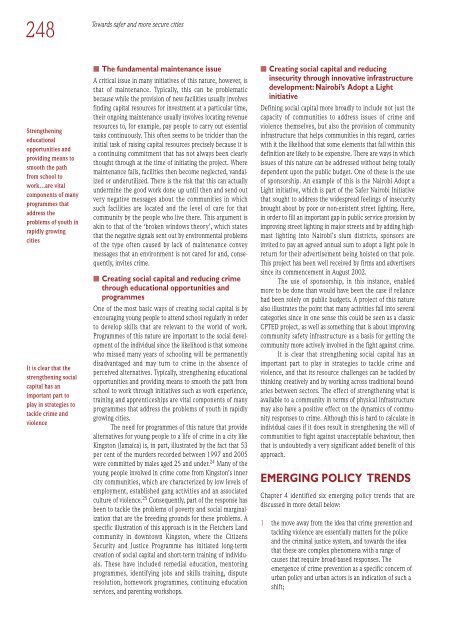Download the file - United Nations Rule of Law
Download the file - United Nations Rule of Law
Download the file - United Nations Rule of Law
- No tags were found...
You also want an ePaper? Increase the reach of your titles
YUMPU automatically turns print PDFs into web optimized ePapers that Google loves.
248Towards safer and more secure citiesStreng<strong>the</strong>ningeducationalopportunities andproviding means tosmooth <strong>the</strong> pathfrom school towork…are vitalcomponents <strong>of</strong> manyprogrammes thataddress <strong>the</strong>problems <strong>of</strong> youth inrapidly growingcitiesIt is clear that <strong>the</strong>streng<strong>the</strong>ning socialcapital has animportant part toplay in strategies totackle crime andviolence■ The fundamental maintenance issueA critical issue in many initiatives <strong>of</strong> this nature, however, isthat <strong>of</strong> maintenance. Typically, this can be problematicbecause while <strong>the</strong> provision <strong>of</strong> new facilities usually involvesfinding capital resources for investment at a particular time,<strong>the</strong>ir ongoing maintenance usually involves locating revenueresources to, for example, pay people to carry out essentialtasks continuously. This <strong>of</strong>ten seems to be trickier than <strong>the</strong>initial task <strong>of</strong> raising capital resources precisely because it isa continuing commitment that has not always been clearlythought through at <strong>the</strong> time <strong>of</strong> initiating <strong>the</strong> project. Wheremaintenance fails, facilities <strong>the</strong>n become neglected, vandalizedor underutilized. There is <strong>the</strong> risk that this can actuallyundermine <strong>the</strong> good work done up until <strong>the</strong>n and send outvery negative messages about <strong>the</strong> communities in whichsuch facilities are located and <strong>the</strong> level <strong>of</strong> care for thatcommunity by <strong>the</strong> people who live <strong>the</strong>re. This argument isakin to that <strong>of</strong> <strong>the</strong> ‘broken windows <strong>the</strong>ory’, which statesthat <strong>the</strong> negative signals sent out by environmental problems<strong>of</strong> <strong>the</strong> type <strong>of</strong>ten caused by lack <strong>of</strong> maintenance conveymessages that an environment is not cared for and, consequently,invites crime.■ Creating social capital and reducing crimethrough educational opportunities andprogrammesOne <strong>of</strong> <strong>the</strong> most basic ways <strong>of</strong> creating social capital is byencouraging young people to attend school regularly in orderto develop skills that are relevant to <strong>the</strong> world <strong>of</strong> work.Programmes <strong>of</strong> this nature are important to <strong>the</strong> social development<strong>of</strong> <strong>the</strong> individual since <strong>the</strong> likelihood is that someonewho missed many years <strong>of</strong> schooling will be permanentlydisadvantaged and may turn to crime in <strong>the</strong> absence <strong>of</strong>perceived alternatives. Typically, streng<strong>the</strong>ning educationalopportunities and providing means to smooth <strong>the</strong> path fromschool to work through initiatives such as work experience,training and apprenticeships are vital components <strong>of</strong> manyprogrammes that address <strong>the</strong> problems <strong>of</strong> youth in rapidlygrowing cities.The need for programmes <strong>of</strong> this nature that providealternatives for young people to a life <strong>of</strong> crime in a city likeKingston (Jamaica) is, in part, illustrated by <strong>the</strong> fact that 53per cent <strong>of</strong> <strong>the</strong> murders recorded between 1997 and 2005were committed by males aged 25 and under. 24 Many <strong>of</strong> <strong>the</strong>young people involved in crime come from Kingston’s innercity communities, which are characterized by low levels <strong>of</strong>employment, established gang activities and an associatedculture <strong>of</strong> violence. 25 Consequently, part <strong>of</strong> <strong>the</strong> response hasbeen to tackle <strong>the</strong> problems <strong>of</strong> poverty and social marginalizationthat are <strong>the</strong> breeding grounds for <strong>the</strong>se problems. Aspecific illustration <strong>of</strong> this approach is in <strong>the</strong> Fletchers Landcommunity in downtown Kingston, where <strong>the</strong> CitizensSecurity and Justice Programme has initiated long-termcreation <strong>of</strong> social capital and short-term training <strong>of</strong> individuals.These have included remedial education, mentoringprogrammes, identifying jobs and skills training, disputeresolution, homework programmes, continuing educationservices, and parenting workshops.■ Creating social capital and reducinginsecurity through innovative infrastructuredevelopment: Nairobi’s Adopt a LightinitiativeDefining social capital more broadly to include not just <strong>the</strong>capacity <strong>of</strong> communities to address issues <strong>of</strong> crime andviolence <strong>the</strong>mselves, but also <strong>the</strong> provision <strong>of</strong> communityinfrastructure that helps communities in this regard, carrieswith it <strong>the</strong> likelihood that some elements that fall within thisdefinition are likely to be expensive. There are ways in whichissues <strong>of</strong> this nature can be addressed without being totallydependent upon <strong>the</strong> public budget. One <strong>of</strong> <strong>the</strong>se is <strong>the</strong> use<strong>of</strong> sponsorship. An example <strong>of</strong> this is <strong>the</strong> Nairobi Adopt aLight initiative, which is part <strong>of</strong> <strong>the</strong> Safer Nairobi Initiativethat sought to address <strong>the</strong> widespread feelings <strong>of</strong> insecuritybrought about by poor or non-existent street lighting. Here,in order to fill an important gap in public service provision byimproving street lighting in major streets and by adding highmastlighting into Nairobi’s slum districts, sponsors areinvited to pay an agreed annual sum to adopt a light pole inreturn for <strong>the</strong>ir advertisement being hoisted on that pole.This project has been well received by firms and advertiserssince its commencement in August 2002.The use <strong>of</strong> sponsorship, in this instance, enabledmore to be done than would have been <strong>the</strong> case if reliancehad been solely on public budgets. A project <strong>of</strong> this naturealso illustrates <strong>the</strong> point that many activities fall into severalcategories since in one sense this could be seen as a classicCPTED project, as well as something that is about improvingcommunity safety infrastructure as a basis for getting <strong>the</strong>community more actively involved in <strong>the</strong> fight against crime.It is clear that streng<strong>the</strong>ning social capital has animportant part to play in strategies to tackle crime andviolence, and that its resource challenges can be tackled bythinking creatively and by working across traditional boundariesbetween sectors. The effect <strong>of</strong> streng<strong>the</strong>ning what isavailable to a community in terms <strong>of</strong> physical infrastructuremay also have a positive effect on <strong>the</strong> dynamics <strong>of</strong> communityresponses to crime. Although this is hard to calculate inindividual cases if it does result in streng<strong>the</strong>ning <strong>the</strong> will <strong>of</strong>communities to fight against unacceptable behaviour, <strong>the</strong>nthat is undoubtedly a very significant added benefit <strong>of</strong> thisapproach.EMERGING POLICY TRENDSChapter 4 identified six emerging policy trends that arediscussed in more detail below:1 <strong>the</strong> move away from <strong>the</strong> idea that crime prevention andtackling violence are essentially matters for <strong>the</strong> policeand <strong>the</strong> criminal justice system, and towards <strong>the</strong> ideathat <strong>the</strong>se are complex phenomena with a range <strong>of</strong>causes that require broad-based responses. Theemergence <strong>of</strong> crime prevention as a specific concern <strong>of</strong>urban policy and urban actors is an indication <strong>of</strong> such ashift;
















